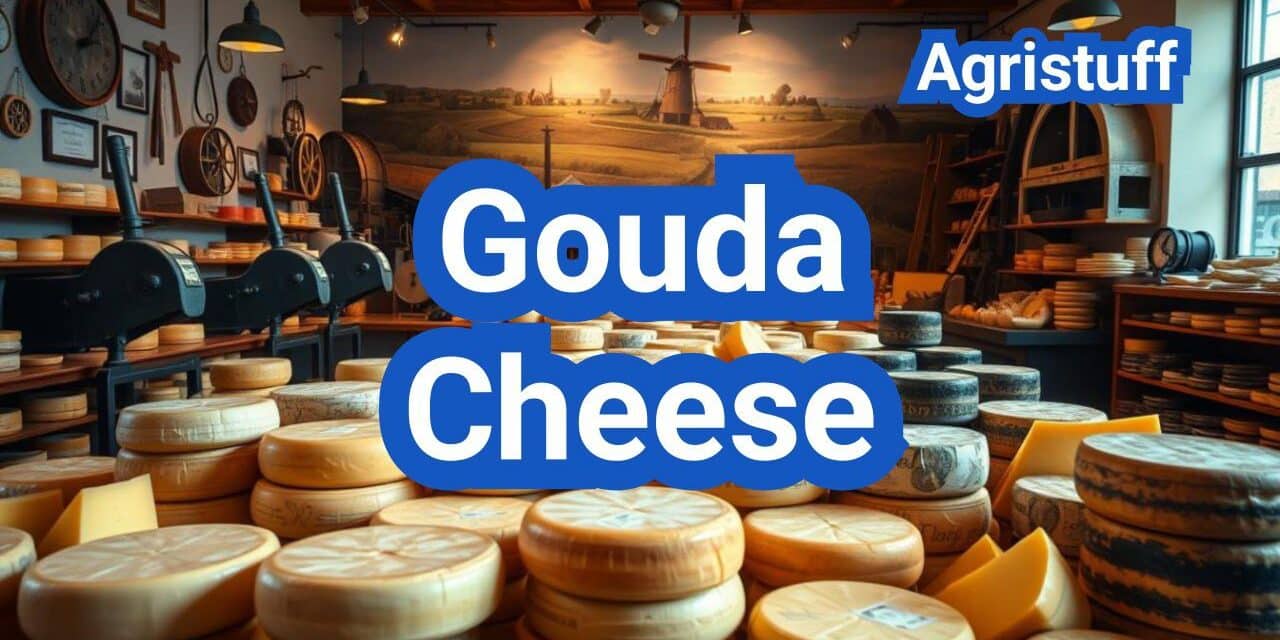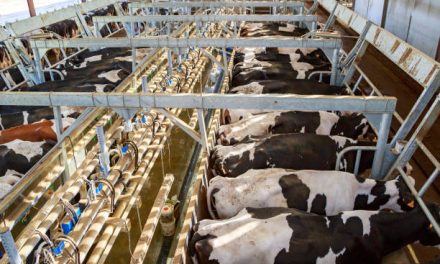Gouda Cheese, a Dutch masterpiece, this semi-hard cheese has been a favorite among cheese enthusiasts for centuries. Its rich, creamy texture and nutty flavor profile make it a versatile choice for various culinary applications.
The origins of this beloved cheese date back to the city of Gouda in the Netherlands, where it was first produced. Over time, different types have emerged, ranging from young and mild to aged with a caramelized crunch.
Understanding the history and processing steps of Gouda Cheese can enhance appreciation for this artisanal product.
Key Takeaways
- Gouda Cheese originates from the Netherlands.
- It is known for its rich texture and nutty flavor.
- Types of Gouda range from young and mild to aged.
- The cheese has a rich history dating back centuries.
- Understanding its production enhances appreciation.
The Rich Heritage of Gouda Cheese
For centuries, Gouda cheese has been a significant part of Dutch cuisine, with its history deeply intertwined with the country’s culture. The story of Gouda cheese is one of tradition, innovation, and cultural exchange.
Origins in the Netherlands
Gouda cheese traces its roots to the Netherlands, specifically to the town of Gouda, where it was historically traded as early as the 12th century. Despite its name, Gouda was not necessarily made in this city; instead, local farmers from different regions would bring their cheese to the Gouda market for sale. This practice not only contributed to the cheese’s popularity but also played a crucial role in establishing Gouda as a staple in Dutch cuisine.
Evolution Through the Centuries
Over the centuries, Gouda cheese has undergone significant transformations, influenced by various factors such as advancements in cheesemaking techniques, changes in consumer preferences, and the impact of historical events. Despite these changes, Gouda has maintained its traditional character while adapting to new trends, ensuring its continued popularity. The evolution of Gouda cheese is a testament to the Dutch ability to blend tradition with innovation.
The significance of Gouda cheese in Dutch culture cannot be overstated. It has been a part of the country’s culinary identity for so long that it is often considered a symbol of Dutch heritage. The cheese’s rich flavor profile, coupled with its versatility in culinary applications, has made it a favorite among cheese enthusiasts worldwide.
The historical context of Gouda cheese production is also noteworthy. The cheese was initially produced on farms and in monasteries, where it was made using traditional methods passed down through generations. As trade and commerce developed, Gouda cheese became an important commodity in the Netherlands, further enhancing its reputation.
Understanding Gouda Cheese Fundamentals

As a washed-curd cheese, Gouda has distinct characteristics that set it apart from other types of cheese. This characteristic is fundamental to its unique taste and texture.
What Makes Gouda Unique
Gouda cheese is known for its rich flavor profile and versatility in culinary applications. The production process, including the washing of the curd, contributes to its distinctive taste. This process involves rinsing the curds in warm water, which removes some of the lactose and contributes to the cheese’s mild flavor.
The aging process also plays a crucial role in the development of Gouda’s characteristics. Young Gouda is mild and creamy, while aged Gouda becomes sharper and more complex.
Nutritional Profile and Calories
Gouda cheese is not only delicious but also offers several nutritional benefits. It is rich in calcium, which is essential for bone health, and high in protein, making it a satisfying snack. Additionally, Gouda contains Vitamin K2, which is important for bone and cardiovascular health.
In terms of calories, Gouda cheese can vary depending on its age and fat content. Generally, a serving of Gouda (about 28g) contains around 100-120 calories. It’s also worth noting that Gouda, like other cheeses, can have probiotic properties, especially when it’s not overly processed.
Understanding the nutritional profile of Gouda cheese can help consumers make informed choices about incorporating it into their diet. With its balance of protein, calcium, and other nutrients, Gouda can be a healthy addition to a balanced diet.
Exploring Gouda Cheese Types
Gouda cheese is renowned for its diverse range of types, each with unique characteristics shaped by factors like age and production methods. The versatility of Gouda cheese is a significant factor in its global popularity, as it caters to a wide range of tastes and culinary applications.
Young Gouda Characteristics
Young Gouda, typically aged between 1 to 3 months, is known for its mild flavor and smooth texture. It is often characterized by its creamy taste and soft, springy texture, making it a favorite among those who prefer milder cheeses. Young Gouda is excellent for snacking, grating, or melting in recipes.
Key Features of Young Gouda:
- Mild and creamy flavor
- Soft and springy texture
- Ideal for snacking and cooking
Mature and Aged Gouda Varieties
As Gouda ages, it develops a richer, more pronounced flavor. Mature Gouda, aged for several months, offers a deeper taste experience, while aged Gouda, which can be aged for up to a year or more, becomes even sharper and more complex. The aging process contributes to a harder texture and a more nuanced flavor profile.
The aging process enhances the natural flavors of Gouda, resulting in a more robust cheese.
Characteristics of Aged Gouda:
- Rich and pronounced flavor
- Harder texture
- Complex taste profile
Smoked Gouda Production
Smoked Gouda is produced by exposing the cheese to smoke, which infuses it with a distinct smoky flavor. This process can be achieved through traditional smoking methods or by using liquid smoke. Smoked Gouda offers a unique twist on the traditional Gouda taste, appealing to those who enjoy smoky flavors.
Flavored Gouda Varieties
Flavored Gouda cheeses are infused with various ingredients to create unique taste experiences. Flavors can range from herbs and spices to fruit and other ingredients, offering a diverse array of Gouda cheeses. Flavored Gouda is versatile and can be used in cooking, as a topping, or enjoyed on its own.
Popular Flavored Gouda Varieties:
- Garlic and Herb Gouda
- Fruit-infused Gouda
- Spicy Gouda
Protected Designations: Authentic Gouda

Gouda cheese’s rich heritage is preserved through protected designations like PGI and PDO. These certifications are crucial in maintaining the authenticity and quality of Gouda cheese produced in specific regions of the Netherlands.
Gouda Holland PGI Certification
The Gouda Holland PGI (Protected Geographical Indication) certification, granted in 2006, ensures that a significant part of the production process of this cheese takes place within the Netherlands. This designation highlights the cheese’s connection to its place of origin and ensures that it adheres to traditional production methods.
Key aspects of Gouda Holland PGI include:
- Production must occur in the Netherlands
- Adherence to traditional methods
- Quality control measures
Noord-Hollandse Gouda PDO Standards
Noord-Hollandse Gouda was awarded PDO (Protected Designation of Origin) status in 1996, signifying that every stage of its production, from milk to the final product, must take place within the Noord-Holland province. This stringent requirement ensures the cheese’s authenticity and ties it closely to its region of origin.
The PDO status for Noord-Hollandse Gouda implies:
- All production stages occur in Noord-Holland
- Strict adherence to traditional production techniques
- Enhanced quality and authenticity
The distinction between PGI and PDO is significant. While PGI requires a certain stage of production to occur within a specific region, PDO demands that the entire production process, from start to finish, takes place within that region. This difference underscores the unique characteristics and production methods associated with each designation.
| Certification | Year Granted | Production Requirements |
|---|---|---|
| Gouda Holland PGI | 2006 | Significant production in the Netherlands |
| Noord-Hollandse Gouda PDO | 1996 | All production in Noord-Holland province |
As noted by cheese experts, “The protected designations for Gouda cheese not only protect its name but also ensure that consumers receive a product that is true to its heritage and made according to traditional standards.”
“The authenticity and quality of Gouda cheese are directly linked to its geographical origin and the traditional methods employed in its production.”
Step-by-Step Gouda Cheese Making Process
Creating authentic Gouda cheese is a multi-stage process that balances tradition with modern techniques. The production of Gouda cheese follows a meticulous process that starts with fresh cow’s milk, though variations using sheep’s or goat’s milk also exist.
Step1: Milk Selection and Preparation
The journey to making Gouda cheese begins with the selection of high-quality milk. Fresh cow’s milk is typically used, but some variations may include sheep’s or goat’s milk. The milk is then pasteurized to eliminate any harmful bacteria while preserving the natural flora necessary for cheese production.
Step2: Curd Formation and Cutting
The next step involves adding a starter culture to the milk to convert the milk sugar (lactose) into lactic acid, initiating the curdling process. Rennet is then added to coagulate the milk, forming a solid curd. The curd is cut into small pieces to release whey and create a smooth, even texture in the final cheese.
“The quality of the milk directly impacts the flavor and quality of the final Gouda cheese.”
Step3: The Distinctive Washing Process
A distinctive feature of Gouda cheese production is the washing process. After the curd is cut, it is washed with water to remove some of the lactose, resulting in a milder flavor. This step also contributes to Gouda’s characteristic yellow color and supple texture.
Step4: Molding and Pressing Techniques
The curd is then molded into its final shape, typically a wheel. The cheese is pressed to expel any remaining whey and to give it its desired shape and firmness. The pressure is gradually increased to prevent damage to the curd.
By following these precise steps, Gouda cheese makers can produce a wide range of Gouda varieties, from young and mild to aged and complex, each with its unique characteristics and flavors.
Essential Equipment for Gouda Cheese Production
The art of Gouda Cheese making is significantly influenced by the choice of equipment, whether traditional or modern. The quality and character of Gouda Cheese are directly affected by the tools and machinery used in its production.
Traditional Dutch Cheesemaking Tools
Traditional Dutch cheesemaking tools have been used for centuries in the production of Gouda Cheese. These tools include wooden molds, cheesecloth, and hand-cranked presses. The use of these traditional tools allows cheesemakers to maintain the heritage and authenticity of Gouda Cheese.
Key traditional tools:
- Wooden molds for shaping the cheese
- Cheesecloth for wrapping and aging
- Hand-cranked presses for applying pressure
As noted by cheese experts, “The traditional methods and tools used in Gouda Cheese production contribute significantly to its unique flavor and texture.”
“The art of cheesemaking is as much about the tools as it is about the technique,” says a renowned cheesemaker.
Modern Commercial and Home Equipment
In contrast to traditional methods, modern commercial and home equipment offer efficiency and consistency in Gouda Cheese production. Modern equipment includes stainless steel vats, automated cutting and stirring systems, and temperature-controlled aging rooms.
Advantages of modern equipment:
- Stainless steel vats for improved hygiene
- Automated systems for precise control
- Temperature-controlled aging rooms for consistent aging
The choice between traditional and modern equipment often depends on the scale of production and the desired characteristics of the final product. Many commercial producers now combine traditional techniques with modern technology to achieve high-quality Gouda Cheese.
The Science and Art of Aging Gouda Cheese

Gouda cheese, as it ages, becomes a delicacy with a rich and intense flavor profile. The aging process is a complex interplay of biochemical reactions that transform the cheese’s texture and taste. Aged Gouda is particularly prized for its deep, nuanced flavors.
Flavor Development Timeline
The flavor of Gouda cheese evolves significantly as it ages. Initially, young Gouda has a mild, creamy taste. As it matures, it develops a sharper, more pronounced flavor, often characterized by notes of butterscotch and caramel.
- Young Gouda (1-3 months): Mild and creamy
- Mature Gouda (3-6 months): Slightly sharper, with emerging complexity
- Aged Gouda (6-12 months and beyond): Rich, intense, with caramel and butterscotch notes
Tyrosine Crystal Formation
One of the distinctive features of aged Gouda is the formation of tyrosine crystals. These crystals contribute to the cheese’s crunchy texture and are a sign of its age and quality. The formation of tyrosine crystals is a result of the breakdown of proteins during the aging process.
| Aging Period | Flavor Profile | Texture |
|---|---|---|
| 1-3 months | Mild, creamy | Soft |
| 3-6 months | Sharper, emerging complexity | Firmer |
| 6-12 months | Rich, intense, caramel notes | Crumbly, with tyrosine crystals |
Young vs. Aged Gouda: A Comprehensive Comparison

From the creamy young Gouda to the robust aged Gouda, the differences are not just in age but in the complexity and depth of flavor and texture.
Texture and Appearance Differences
Young Gouda, typically aged for a few weeks to a few months, has a soft and supple texture, making it ideal for spreading on crackers or bread. In contrast, aged Gouda, which can be aged from several months to several years, becomes harder and more crumbly. The aging process concentrates the cheese’s natural fats and proteins, leading to a more rugged texture.
The appearance also changes significantly with age. Young Gouda has a smooth, pale yellow color, while aged Gouda develops a darker, more golden hue and may exhibit tyrosine crystals, which are tiny, crunchy deposits that form during the aging process.
Flavor Profile Evolution
The flavor profile of Gouda cheese undergoes a significant transformation as it ages. Young Gouda is characterized by its mild, creamy flavor, which is slightly sweet and nutty. As Gouda ages, the flavor becomes more pronounced and complex, developing notes of caramel, nuts, and sometimes a hint of saltiness.
Aged Gouda can have a rich, deep flavor that is often described as nutty, savory, and slightly sweet. The aging process allows for the development of a more intricate flavor profile, making aged Gouda a favorite among cheese connoisseurs.
Culinary Applications
Both young and aged Gouda have their unique culinary applications. Young Gouda is perfect for snacking, grating, or melting in dishes like macaroni and cheese or grilled cheese sandwiches. Its mild flavor and creamy texture make it a versatile ingredient in many recipes.
Aged Gouda, with its robust flavor, is ideal for grating over pasta dishes, salads, or soups. It can also be served as a table cheese, paired with fruits and nuts, or used in gourmet grilled cheese sandwiches.
| Characteristics | Young Gouda | Aged Gouda |
|---|---|---|
| Texture | Soft, creamy | Hard, crumbly |
| Flavor | Mild, slightly sweet | Nutty, caramel-like, savory |
| Culinary Use | Snacking, melting, grating | Grating, table cheese, gourmet dishes |
The Distinctive World of Smoked Gouda

Smoked Gouda, with its deep, smoky flavor, has become a favorite among cheese enthusiasts worldwide. This unique variation of Gouda cheese is made by subjecting the cheese to a smoking process, which not only enhances its flavor but also adds to its texture.
Traditional Smoking Methods
The traditional method of smoking Gouda involves cold-smoking over woods like hickory or oak. This process imparts a rich, smoky taste to the cheese without melting it. The cold-smoking technique is crucial as it allows the cheese to absorb the smoky flavor without altering its texture significantly.
Key aspects of traditional smoking methods include:
- Selection of smoking wood, such as hickory or oak, which influences the final flavor.
- Control of temperature to ensure the cheese is not melted during the smoking process.
- Duration of smoking, which can vary depending on the desired intensity of the smoky flavor.
Popular Smoked Gouda Varieties
There are several popular varieties of smoked Gouda, each with its unique characteristics. Some of the most well-known include:
- Applewood-smoked Gouda, which is smoked over applewood, giving it a fruity and mild smoky flavor.
- Hickory-smoked Gouda, known for its robust and traditional smoky taste.
These varieties showcase the versatility of Gouda cheese when it comes to smoking. The choice of wood for smoking can significantly affect the flavor profile, offering a range of options for consumers.
The smoking process not only enhances the flavor but also affects the texture and appearance of Gouda. Smoked Gouda often has a more pronounced color and a slightly firmer texture than its non-smoked counterparts.
The Significance of Gouda Cheese Red Wax

Gouda Cheese is renowned for its distinctive red wax coating, which serves multiple purposes. The red wax coating is not just aesthetically pleasing; it also plays a crucial role in the cheese’s production and preservation.
Historical Purpose and Development
The tradition of coating Gouda Cheese with wax dates back centuries. Originally, the wax coating was used to protect the cheese during its aging process, preventing it from drying out and maintaining its quality. The wax acts as a barrier, shielding the cheese from external factors while it matures.
The development of the red wax coating is closely tied to the history of Gouda Cheese production in the Netherlands. The use of wax was initially a practical solution for preserving the cheese, but over time, it became an integral part of the cheese’s identity.
Color Coding System and Meanings
The color of the wax coating is not merely decorative; it signifies the age and type of Gouda Cheese. The traditional color coding system uses red, yellow, and green to indicate different aging periods.
| Color | Aging Period | Type of Gouda |
|---|---|---|
| Red | Young (less than 3 months) | Young Gouda |
| Yellow | Mature (3-6 months) | Mature Gouda |
| Green or Black | Aged (over 6 months) | Aged Gouda |
As noted by cheese experts, “The wax coating is a critical component in the aging process of Gouda Cheese, influencing both its flavor and texture.”
“The wax coating on Gouda Cheese is a testament to the craftsmanship involved in its production, combining functionality with tradition.”
The red wax coating on Gouda Cheese is a distinctive feature that has become synonymous with quality and tradition. Understanding the significance of this coating enhances appreciation for the craftsmanship involved in producing this iconic cheese.
Perfect Pairings for Gouda Cheese

Exploring the perfect pairings for Gouda cheese reveals a world of flavors and combinations. Gouda cheese, known for its versatility, can be paired with a variety of wines, beers, and foods to enhance its unique characteristics.
Wine Pairings by Gouda Age
The age of Gouda cheese significantly influences its pairing with wine. Young Gouda, with its mild flavor, pairs well with white wines such as Chardonnay or Sauvignon Blanc. In contrast, aged Gouda complements full-bodied red wines like Cabernet Sauvignon or Merlot.
| Gouda Age | Recommended Wine |
|---|---|
| Young Gouda (1-3 months) | Chardonnay, Sauvignon Blanc |
| Aged Gouda (6-12 months) | Cabernet Sauvignon, Merlot |
Beer Selections for Different Goudas
Beer pairing is another exciting way to enjoy Gouda cheese. Smoked Gouda pairs exceptionally well with dark beers like Stout or Porter, while young Gouda can be paired with lighter beers such as Pilsner or Lager.
- Smoked Gouda: Stout, Porter
- Young Gouda: Pilsner, Lager
- Aged Gouda: Ale, Bock
Complementary Foods and Accompaniments
Gouda cheese can be complemented by a variety of foods. Fruits like apples and pears pair nicely with Gouda, while nuts such as almonds provide a satisfying crunch. For a more savory experience, pairing Gouda with charcuterie like prosciutto or salami is recommended.
Charcuterie Board Recommendations
Creating a charcuterie board featuring Gouda cheese involves selecting a mix of complementary items. Include a variety of cheeses, meats, fruits, and nuts. For Gouda, consider pairing it with fig jam or honey for a sweet contrast.
| Item | Description |
|---|---|
| Gouda Cheese | Main cheese feature |
| Fruits | Apples, Pears, Grapes |
| Nuts | Almonds, Walnuts |
| Charcuterie | Prosciutto, Salami |
| Spreads | Fig Jam, Honey |
Cooking with Gouda Cheese: Techniques and Tips

When it comes to cooking, Gouda cheese offers a range of possibilities, thanks to its unique melting properties and rich flavor profile. Gouda’s versatility makes it a favorite among chefs and home cooks alike, suitable for a variety of dishes from comfort food to gourmet cuisine.
Melting Properties and Considerations
Gouda cheese is known for its excellent melting properties, which make it ideal for dishes like grilled cheese sandwiches, macaroni and cheese, and fondue. The melting point of Gouda varies depending on its age; younger Gouda tends to melt more easily than aged Gouda due to its higher moisture content.
Tips for Melting Gouda:
- Use young Gouda (ages 1-3 months) for the creamiest melts.
- Grate or shred the cheese to ensure even melting.
- Combine Gouda with other cheeses for a richer flavor profile.
Understanding the melting properties of Gouda is crucial for achieving the perfect texture in your dishes. Here’s a comparison of how different ages of Gouda melt:
| Gouda Age | Melting Characteristics | Ideal Uses |
|---|---|---|
| Young (1-3 months) | Melts easily, creamy texture | Grilled cheese, sauces, dips |
| Mature (4-6 months) | Melts well, slightly firmer | Macaroni and cheese, casseroles |
| Aged (7 months and older) | Melts less easily, rich flavor | Garnishes, flavor enhancer |
Substituting Gouda in Recipes
Gouda can be substituted in many recipes that call for other cheeses, offering a unique flavor twist. When substituting Gouda, consider its age and the flavor profile you’re aiming for.
Substituting Tips:
- Replace cheddar or mozzarella with young Gouda for a milder flavor.
- Use aged Gouda instead of Parmesan for a nuttier taste.
- Experiment with smoked Gouda for a deeper, smoky flavor.
By understanding how to use Gouda in your cooking and how to substitute it in recipes, you can unlock a world of culinary possibilities and elevate your dishes to new heights.
Signature Gouda Cheese Recipes

Exploring the world of Gouda cheese recipes reveals a multitude of delicious possibilities for culinary creativity. Gouda cheese, with its rich and creamy texture, can be incorporated into a wide variety of dishes, enhancing their flavor and appeal.
Appetizers and Starters
Gouda cheese is an excellent choice for appetizers and starters due to its smooth texture and mild flavor. Some popular ideas include:
- Gouda and Fig Jam Crostini: A sweet and savory combination that pairs well with crackers or bread.
- Gouda Stuffed Mushrooms: Filling mushroom caps with a mixture of Gouda, breadcrumbs, and herbs creates a delicious and savory appetizer.
- Gouda and Prosciutto Wrap: Wrapping thin slices of prosciutto around cubes of Gouda makes for a simple yet elegant snack.
Main Course Dishes
Gouda cheese can also be a key ingredient in main course dishes, adding depth and richness to various recipes. Some examples include:
- Gouda Mac and Cheese: A creamy pasta bake featuring Gouda as the primary cheese.
- Gouda Crusted Chicken: Coating chicken breasts with a mixture of Gouda, breadcrumbs, and spices before baking yields a crispy and flavorful dish.
- Gouda and Spinach Quiche: A quiche filled with Gouda, spinach, and eggs makes for a satisfying main course.
Desserts and Sweet Applications
While Gouda is often associated with savory dishes, it can also be used in sweet applications, particularly when paired with fruits or sweet spreads. Some ideas include:
- Gouda and Apple Tart: Combining Gouda with apples and a flaky pastry crust creates a unique dessert.
- Gouda Cheesecake: Using Gouda in cheesecake recipes can add a rich and creamy texture.
- Gouda and Fig Compote: Serving Gouda with a fig compote and crackers or bread provides a sweet and savory treat.
These signature Gouda cheese recipes showcase the versatility of Gouda in various culinary contexts, from appetizers to desserts. By incorporating Gouda into different dishes, home cooks and chefs can explore new flavors and textures, enhancing their culinary creations.
The Global Gouda Cheese Market
The Gouda Cheese market is shaped by production volumes, consumer preferences, and global trends. Understanding these factors is crucial for both consumers and producers to navigate this complex market effectively.
Production Volumes and Major Producers
Gouda Cheese is primarily produced in the Netherlands, with the city of Gouda being the historical center of production. The Netherlands remains the largest producer, accounting for a significant portion of global Gouda Cheese production.
Other countries, including the United States, Australia, and various European nations, also produce Gouda Cheese, contributing to the global supply. The production volume is influenced by factors such as milk availability, production costs, and market demand.
| Country | Production Volume (Tons) | Market Share (%) |
|---|---|---|
| Netherlands | 180,000 | 60 |
| United States | 45,000 | 15 |
| Australia | 30,000 | 10 |
| Other Countries | 45,000 | 15 |
Price Factors and Consumer Trends
The price of Gouda Cheese is influenced by several factors, including production costs, aging process, and market demand. Aged Gouda Cheese typically commands a higher price due to the longer aging process and the resulting complex flavor profile.
Consumer trends play a significant role in shaping the Gouda Cheese market. There’s a growing demand for artisanal and specialty Gouda Cheeses, driven by consumers seeking unique flavors and high-quality products.
Buying and Storing Tips
When buying Gouda Cheese, consumers should consider the age, type, and production methods. Young Gouda is ideal for snacking and melting, while aged Gouda is better suited for grating or serving as is.
Proper storage is crucial to maintaining the quality of Gouda Cheese. It should be stored in a cool, humid environment, wrapped in wax paper or aluminum foil to prevent drying out.
By understanding the dynamics of the global Gouda Cheese market, consumers can make informed purchasing decisions and enjoy this versatile cheese to its fullest potential.
The Enduring Appeal of Gouda Cheese
Gouda Cheese is a timeless treasure that offers a wide range of flavors and textures, from the creamy, mild young Gouda to the bold, nutty aged varieties. This versatility is a significant factor in its enduring appeal to gouda cheese lovers worldwide.
The rich heritage, diverse types, and cultural significance of Gouda Cheese contribute to its broad appeal. Whether enjoyed on its own, paired with wine or beer, or used in various recipes, Gouda Cheese continues to captivate cheese enthusiasts. Its gouda cheese appeal lies in its adaptability and the depth of flavor it brings to any culinary experience.
As the global Gouda Cheese market continues to evolve, with changing consumer trends and production volumes, the essence of Gouda remains unchanged. It remains a beloved cheese, cherished for its quality and the joy it brings to those who savor it. For anyone exploring the world of cheese, Gouda is an essential discovery, offering a journey through its many ages, flavors, and pairings.
FAQ
What is the origin of Gouda Cheese?
Gouda Cheese originates from the Netherlands, specifically from the city of Gouda in the province of South Holland.
What makes Gouda Cheese unique?
Gouda Cheese is known for its rich, creamy texture and mild, nutty flavor, which develops over time as it ages. The cheese is made from cow’s milk and is characterized by its yellow color and smooth texture.
What are the different types of Gouda Cheese?
Gouda Cheese comes in various types, including young, mature, aged, smoked, and flavored varieties. Young Gouda is mild and creamy, while aged Gouda is rich and nutty. Smoked Gouda has a distinct smoky flavor, and flavored Gouda is infused with various ingredients like cumin or herbs.
What is the difference between young and aged Gouda Cheese?
Young Gouda is mild, creamy, and smooth, while aged Gouda is rich, nutty, and crumbly. The aging process develops the flavor and texture of the cheese, making aged Gouda more complex and robust.
How is Gouda Cheese made?
Gouda Cheese is made through a multi-step process involving milk selection, curd formation, cutting, washing, molding, and pressing. The cheese is then aged to develop its characteristic flavor and texture.
What is the significance of the red wax coating on Gouda Cheese?
The red wax coating on Gouda Cheese serves as a protective barrier, preventing the cheese from drying out and developing off-flavors. The color coding system on the wax coating indicates the age of the cheese, with red typically signifying aged Gouda.
How should I store Gouda Cheese?
Gouda Cheese should be stored in the refrigerator, wrapped in wax paper or plastic wrap to prevent drying out. It’s best consumed within a few weeks of opening, and it’s recommended to store it at a consistent refrigerator temperature.
What are some popular pairings for Gouda Cheese?
Gouda Cheese pairs well with a variety of foods and drinks, including wine, beer, fruit, and crackers. Young Gouda is often paired with white wine, while aged Gouda is paired with red wine or beer. Gouda is also a great addition to charcuterie boards and can be used in various recipes.
Can I melt Gouda Cheese?
Yes, Gouda Cheese can be melted, and it’s often used in recipes like grilled cheese, sauces, and soups. Young Gouda melts more easily than aged Gouda, which can be more crumbly and granular.
Is Gouda Cheese a healthy option?
Gouda Cheese is a good source of calcium, protein, and other nutrients. However, it’s also relatively high in calories and saturated fat. Moderation is key when consuming Gouda Cheese as part of a balanced diet.
Conclusion of: Gouda Cheese
Gouda Cheese: A Clear Definition and Why It Matters
Gouda cheese is a classic semi-hard Dutch-style cheese prized across the U.S. for its buttery texture, gentle sweetness, and wide culinary versatility, and understanding what gouda cheese means on labels (style versus protected origin) helps shoppers pick the right wedge for sandwiches, snacking, or cooking. Encyclopaedia Britannica — Gouda (city & heritage)
Gouda Cheese: A Short History from the Netherlands to Your Plate
Although it’s named after the city of Gouda, gouda cheese historically traveled from surrounding farms to the city’s famous market, where merchants weighed wheels and haggled by a traditional hand-clap—rituals that shaped the global trade identity of gouda cheese. Official Gouda Cheese Market — Gouda Kaasstad
Gouda Cheese in U.S. Law: Standard of Identity
In the United States, gouda cheese is defined by a federal Standard of Identity requiring at least 46% milkfat in the solids and no more than 45% moisture, ensuring that gouda cheese on American shelves meets predictable composition and quality. Cornell Law LII — 21 CFR §133.142 (Gouda)
Gouda Cheese and the 60-Day Rule (Raw vs. Pasteurized)
Whether made from pasteurized or raw milk, gouda cheese sold in the U.S. must comply with safety rules, and raw-milk gouda cheese is subject to aging requirements and ongoing FDA surveillance, which informs consumers about risk and quality. FDA — Raw Milk Safety Overview
Protected Names for Gouda Cheese: PGI & PDO
On imported products, you may see protected names like “Gouda Holland” (PGI) and “Noord-Hollandse Gouda” (PDO), and these marks tell U.S. buyers that the gouda cheese meets location and production specifications that influence flavor and texture. EU — Gouda Holland PGI & Noord-Hollandse Gouda PDO
Types of Gouda Cheese by Age (Young to Very Old)
Producers sort gouda cheese by ripening time—from weeks-old “young” to 18–24-month “very old”—and as gouda cheese ages, moisture decreases while flavors intensify from milky and sweet to nutty, caramelized, and savory. Wisconsin Cheese — Gouda Guide
Young vs. Aged Gouda Cheese: Flavor, Texture, and Meltability
For oozy grilled cheeses and casseroles, young gouda cheese melts smoothly and tastes mellow, while aged gouda cheese turns firm and crumbly with butterscotch and toasted-nut notes that shine on boards and in gratins. Wisconsin Cheese — Young vs. Aged Characteristics
Why Gouda Cheese Tastes Sweet: Washed-Curd Science
By draining whey and replacing it with warm water, the washed-curd method reduces lactose—and therefore acid—so young gouda cheese keeps a sweet, buttery profile compared with tangier unwashed-curd varieties, a hallmark of gouda cheese making. CheeseScience.org — Washed-Curd Cheeses
How Gouda Cheese Is Made: The Processing Steps
Typical steps for gouda cheese include culturing and renneting the milk, cutting the curd, washing to control acidity, cooking and stirring to set texture, molding and pressing to form wheels, brining to set salt and rind, coating (wax or plastic), and aging to develop the final gouda cheese character. University of Guelph — Cheese Making Technology e-Book
Milk, Cultures, and Coagulation in Gouda Cheese
Choice of milk (cow’s milk is standard), culture strains, and rennet type controls acidification and texture, and small differences at these early stages can steer young or aged gouda cheese toward milder or bolder outcomes in the finished gouda cheese. University of Guelph — Starter Cultures & Coagulation
Pressing, Brining, and Rind Formation for Gouda Cheese
Pressing expels whey and evens the body, while brining governs salt uptake and rind development, and these parameters give gouda cheese its signature sliceability and longevity across both young and aged gouda cheese styles. Tetra Pak — Cheese Brining Systems
Essential Equipment for Gouda Cheese (Farmhouse & Plant Scale)
From HTST pasteurizers and jacketed vats with curd knives to brining systems, presses, waxing lines, and humidity-controlled aging rooms, the right equipment keeps gouda cheese consistent and safe during production at any scale. Tetra Pak — Equipment Role in Quality
Smoked Gouda Cheese: Real Smoke vs. Smoke Flavor
Producers may cold-smoke gouda cheese with wood or use declared smoke condensates, and accurate U.S. labeling helps buyers distinguish true smoked gouda cheese from smoke-flavored styles when comparing options. UW–Madison CDR — Smoke Flavoring in Cheese
Why Aged Gouda Cheese Gets Crunchy (Crystals!)
With time, proteins in gouda cheese break down and amino acids like tyrosine cluster into tiny crystals, while calcium lactate can form on surfaces, adding a pleasant crunch that signals deeply aged gouda cheese. CheeseScience.org — Cheese Crystal Myths
Nutrition Snapshot: How Gouda Cheese Fits a U.S. Diet
Per ounce, gouda cheese averages about 100 calories with roughly 7 g protein and meaningful calcium and phosphorus, so portion-aware servings of gouda cheese can support satisfying snacks and balanced dishes. MyFoodData (USDA-based) — Gouda Nutrition
Lactose, Sodium, and Storage Tips for Gouda Cheese
Because fermentation reduces residual lactose, gouda cheese is often easier to digest than fresh dairy for some people, and well-wrapped gouda cheese stored at 34–38°F maintains quality for weeks once cut. FoodSafety.gov — Cold Food Storage Charts
Best Wine Pairings with Gouda Cheese
Young gouda cheese loves fruit-forward whites like Riesling and Pinot Grigio or light reds like Pinot Noir, while aged gouda cheese stands up to structured reds and oak-touched Chardonnay, creating balanced boards around gouda cheese. Wine Enthusiast — Cheese & Wine Pairings
Best Beer Pairings with Gouda Cheese
Crisp pilsners and Kölsch accent the sweetness of young gouda cheese, while malt-rich bock, brown ale, and stout mirror the toffee and nut tones of aged gouda cheese for crowd-pleasing pairings centered on gouda cheese. Wisconsin Cheese — Beer & Cheese Pairing
Easy Food Pairings for Gouda Cheese at Home
Build simple boards by pairing young gouda cheese with apples, pears, and honey-mustard, and set aged gouda cheese beside roasted nuts, dark chocolate, and fig jam so guests can compare styles of gouda cheese. New England Dairy — Pairing Ideas
Cooking with Gouda Cheese: Melting, Grating, and Browning
For grilled sandwiches and bakes, young gouda cheese melts smoothly and stays stretchy, while grated aged gouda cheese adds bold finish to soups and gratins, and a blend can give any dish balanced gouda cheese flavor. Wisconsin Cheese — Cooking Tips
Buying Tips: Labels, Coatings, and What to Look For
When you shop for gouda cheese, scan for age markers (“young,” “mature,” “aged”), quality seals (PGI/PDO), and intact coatings, then rewrap cut gouda cheese tightly at home to protect moisture and aroma. EU — Quality & Origin Schemes
U.S. Labeling Basics and Safety for Gouda Cheese
Ingredient statements and allergen disclosures help you compare brands of gouda cheese, and understanding pasteurized versus raw-milk labels lets households choose the gouda cheese that fits their preferences and health needs. eCFR — 21 CFR Part 133 (Cheeses)
Where Tradition Meets Versatility: Why Americans Love Gouda Cheese
For everyday cooks, the appeal of gouda cheese is range—one style with many expressions—so you can melt young gouda cheese during the week, present aged gouda cheese on weekends, and keep smoked gouda cheese on hand for a campfire note. Britannica — Gouda’s Heritage
Final Thought
Whether you prefer tender and melty or crystalline and bold, gouda cheese rewards curiosity: explore different ages, try smoked versions, and pair thoughtfully, and you’ll discover why gouda cheese is a perennial U.S. favorite for sandwiches, boards, and cooking. Wisconsin Cheese — Explore Gouda
Sources & References
- Cornell Law LII — 21 CFR §133.142 (Gouda cheese)
- eCFR — 21 CFR Part 133 (Cheeses & Related Cheese Products)
- FDA — Raw Milk Safety Overview
- European Commission — Gouda Holland (PGI) & Noord-Hollandse Gouda (PDO)
- Gouda Kaasstad — Official Cheese Market
- University of Guelph — Cheese Making Technology e-Book
- CheeseScience.org — Washed-Curd Cheese Explanation
- Wisconsin Cheese — Gouda Overview
- Wisconsin Cheese — Beer & Cheese Pairing
- MyFoodData (USDA-based) — Gouda Nutrition Facts
- FoodSafety.gov — Cold Food Storage Charts










